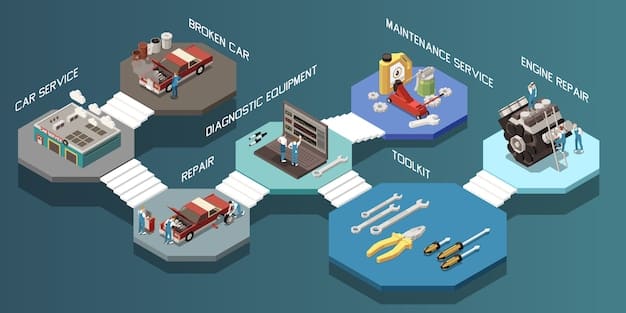Sustainable Cars: How Automakers Adapt to Green Materials Demand

Automakers are adapting to the increasing demand for sustainable materials in car manufacturing by investing in research and development of bio-based plastics, recycled metals, and natural fibers to reduce environmental impact and meet consumer expectations for eco-friendly vehicles.
The automotive industry is undergoing a significant transformation, driven by increasing consumer demand for environmentally friendly products. One of the most impactful changes is how car manufacturers are adapting to the increasing demand for sustainable materials in car manufacturing.
The Shift Towards Sustainable Materials in Automotive Manufacturing
The automotive industry is experiencing a paradigm shift, increasingly focusing on sustainable practices. Consumers are more aware of the environmental impact of their purchasing decisions, and this awareness is driving demand for vehicles made with sustainable materials.
This section explores the key drivers behind the automotive industry’s shift towards sustainable materials, highlighting the increasing consumer demand and the push for environmentally responsible manufacturing processes.
Consumer Demand for Eco-Friendly Vehicles
Consumers are increasingly factoring in sustainability when purchasing a new vehicle. They are searching for cars that not only have excellent fuel efficiency but also use materials that are less harmful to the environment.
Regulatory Pressures and Incentives
Government regulations play a crucial role in steering automakers towards sustainable materials. Stricter emissions standards and waste management policies are pushing manufacturers to innovate and adopt greener practices. Additionally, government incentives for using recycled and renewable materials are further accelerating this transition.
- Reducing carbon footprint in manufacturing processes.
- Utilizing materials that are recyclable or biodegradable.
- Complying with environmental regulations and standards.

In conclusion, the shift towards sustainable materials in automotive manufacturing is driven by consumer demand and regulatory pressures. Automakers are increasingly focusing on eco-friendly materials to reduce their environmental impact and meet evolving consumer expectations.
Innovative Materials Revolutionizing Car Manufacturing
The automotive industry is witnessing a revolution in material science, with manufacturers exploring a wide range of innovative materials to create more sustainable vehicles. These materials are not only environmentally friendly but also offer unique performance benefits.
This section explores some of the most promising innovative materials being adopted by car manufacturers, including bio-based plastics, recycled metals, and natural fibers, and how these materials are revolutionizing car manufacturing.
Bio-Based Plastics: A Renewable Alternative
Bio-based plastics are derived from renewable resources such as corn, sugarcane, and vegetable oils. They offer a lower carbon footprint compared to traditional petroleum-based plastics. Automakers are using bio-based plastics in interior components like dashboards, door panels, and seat cushions.
Recycled Metals: Closing the Loop
Recycled metals, such as aluminum and steel, are gaining popularity in car manufacturing. Using recycled metals reduces the need for mining virgin materials, saving energy and reducing greenhouse gas emissions. Automakers are incorporating recycled metals in structural components, engine parts, and body panels.

Automakers are exploring the use of natural fibers such as hemp, flax, and jute as reinforcement materials in composites. These natural fibers are lightweight, strong, and biodegradable, making them an attractive alternative to traditional materials like fiberglass. They are used in door panels, trunk liners, and headliners.
- Implementation of bio-based plastics in interior automotive elements.
- Utilization of recycled metals to reduce the need for mining virgin materials.
- Incorporation of natural fibers for reinforced composites in car manufacturing.
In conclusion, innovative materials are revolutionizing car manufacturing by offering sustainable alternatives to traditional materials. Bio-based plastics, recycled metals, and natural fibers are some of the most promising materials being adopted by car manufacturers to reduce their environmental impact and create greener vehicles.
Strategies Automakers Are Implementing for Sustainability
Automakers are adopting various strategies to integrate sustainability into their manufacturing processes and supply chains. These strategies range from investing in research and development to collaborating with suppliers and implementing circular economy principles.
This section explores the key sustainability strategies being implemented by automakers, including investments in R&D, supply chain collaboration, and circular economy initiatives.
Investing in Research and Development
Automakers are investing heavily in research and development to discover new sustainable materials and manufacturing processes. This investment is crucial for developing innovative solutions that can reduce the environmental impact of car manufacturing.
Supply Chain Collaboration
Collaboration with suppliers is essential for automakers to ensure the sustainability of their entire supply chain. By working closely with suppliers, manufacturers can promote the use of sustainable materials and practices throughout the supply chain.
Automakers are embracing circular economy principles to minimize waste and maximize resource utilization. This includes designing vehicles for disassembly and recyclability, as well as implementing closed-loop manufacturing processes.
- Collaborating with material science researchers to find sustainable alternatives.
- Partnering with suppliers who prioritize eco-friendly production processes.
- Adopting strategies to ensure the safe and responsible end-of-life treatment of vehicles.
In conclusion, automakers are implementing comprehensive strategies to integrate sustainability into their operations. Investing in R&D, collaborating with suppliers, and embracing circular economy principles are key strategies for reducing environmental impact.
Real-World Examples of Sustainable Material Usage in Cars
Several automakers have already started incorporating sustainable materials into their vehicles, showcasing the viability and benefits of these materials. These real-world examples provide valuable insights into how sustainable materials can be effectively used in car manufacturing.
This section highlights real-world examples of sustainable material usage in cars, providing insights into the application of bio-based plastics, recycled materials, and natural fibers in existing vehicle models.
Bio-Based Plastics in Ford Vehicles
Ford has been a pioneer in using bio-based plastics in their vehicles. The company has incorporated soy-based foam in seat cushions and castor oil-based foam in instrument panels. These bio-based materials reduce reliance on petroleum and lower carbon emissions.
Recycled Materials in Volvo Cars
Volvo is committed to using recycled materials in its vehicles. The company has incorporated recycled plastic bottles in carpets and recycled fishing nets in interior trim. These efforts contribute to reducing plastic waste and promoting a circular economy.
BMW has been exploring the use of natural fibers in its vehicles. The company has used flax fibers in door panels. Natural fibers offer a lightweight and sustainable alternative to traditional materials.
- Discuss how Ford integrates soybean-derived foam into seat cushions.
- Detail Volvo’s use of recycled materials, such as plastics from the ocean.
- Explain how BMW uses flax fibers to reduce the overall weight of the vehicle.
In conclusion, real-world examples demonstrate the feasibility and benefits of using sustainable materials in cars. Ford, Volvo, and BMW are leading the way by incorporating bio-based plastics, recycled materials, and natural fibers into their vehicles, paving the way for a more sustainable automotive industry.
The Benefits of Sustainable Materials for Automakers and Consumers
The shift towards sustainable materials in car manufacturing offers a multitude of benefits for both automakers and consumers. From reducing environmental impact to enhancing vehicle performance, the advantages are compelling.
This section outlines the key benefits of using sustainable materials in car manufacturing, including reduced environmental impact, improved vehicle performance, and enhanced brand reputation.
Reduced Environmental Impact
Sustainable materials have a lower carbon footprint compared to traditional materials. They reduce greenhouse gas emissions, conserve natural resources, and minimize waste.
Improved Vehicle Performance
Some sustainable materials, such as natural fibers and lightweight composites, can improve vehicle performance. They reduce vehicle weight, leading to better fuel efficiency and handling.
Using sustainable materials can enhance an automaker’s brand reputation. Consumers are more likely to purchase vehicles from companies that demonstrate a commitment to sustainability.
- Highlight how sustainable materials contribute to a lower overall carbon footprint.
- Explain how the use of lighter materials improves vehicle efficiency.
- Detail how prioritizing sustainability enhances the automaker’s brand image.
In conclusion, sustainable materials offer significant benefits for automakers and consumers. Reduced environmental impact, improved vehicle performance, and enhanced brand reputation are compelling reasons for embracing sustainable materials in car manufacturing.
Challenges and Opportunities in Adopting Sustainable Materials
While the adoption of sustainable materials in car manufacturing is gaining momentum, there are still challenges that need to be addressed. Overcoming these challenges will unlock new opportunities and accelerate the transition towards a more sustainable automotive industry.
This section examines the challenges and opportunities associated with adopting sustainable materials in car manufacturing, including material costs, supply chain complexities, and performance considerations.
Material Costs and Availability
Sustainable materials can sometimes be more expensive than traditional materials. This cost difference can be a barrier to widespread adoption. Additionally, the availability of sustainable materials may be limited in some regions.
Supply Chain Complexities
Implementing sustainable materials requires establishing new supply chains. This can be complex and time-consuming, as automakers need to ensure that their suppliers meet sustainability standards.
Some sustainable materials may not perform as well as traditional materials in certain applications. Automakers need to carefully evaluate the performance characteristics of sustainable materials to ensure they meet safety and durability requirements.
- Address the cost concerns that automakers may have when considering sustainable materials.
- Discuss the challenges associated with creating new, eco-friendly supply chains.
- Show how automakers can test and validate new materials for safety and durability.
In conclusion, adopting sustainable materials in car manufacturing involves addressing challenges related to material costs, supply chain complexities, and performance considerations. Overcoming these challenges will unlock new opportunities and pave the way for a more sustainable automotive industry.
| Key Point | Brief Description |
|---|---|
| 🌱 Bio-Based Plastics | Renewable alternatives reducing carbon footprint. |
| ♻️ Recycled Metals | Reduces need for mining, saving energy & emissions. |
| 🌿 Natural Fibers | Lightweight, strong, and biodegradable composites. |
| 🤝 Supply Chain | Collaboration ensures sustainability throughout the chain. |
Frequently Asked Questions
▼
Bio-based plastics are plastics derived from renewable resources. These materials are sourced from biomass, such as cornstarch, sugarcane, or vegetable oils, offering a more sustainable alternative to traditional petroleum-based plastics.
▼
Recycled metals reduce the need for extracting new metals from the earth. This process saves energy, reduces pollution, and lowers greenhouse gas emissions. It also supports the principles of a circular economy.
▼
Natural fibers like hemp, flax, and jute are lightweight, strong, and biodegradable. Furthermore, they are renewable and reduce the environmental impact compared to synthetic fibers. They also offer good insulation properties.
▼
Sustainable materials can actually improve car performance by reducing vehicle weight, which leads to better fuel efficiency and handling. Extensive testing ensures that these materials meet safety and durability standards.
▼
Consumers can support it through research that favors automakers that invest in sustainable materials. Furthermore, individuals can opt to properly dispose of or recycle their current vehicles and also advocate for policies that promote sustainability.
Conclusion
In conclusion, the automotive industry is making significant strides in adapting to the increasing demand for sustainable materials. By embracing innovative materials, implementing strategic initiatives, and addressing existing challenges, automakers pave the way for a more sustainable and eco-friendly future for the industry and consumers alike.





